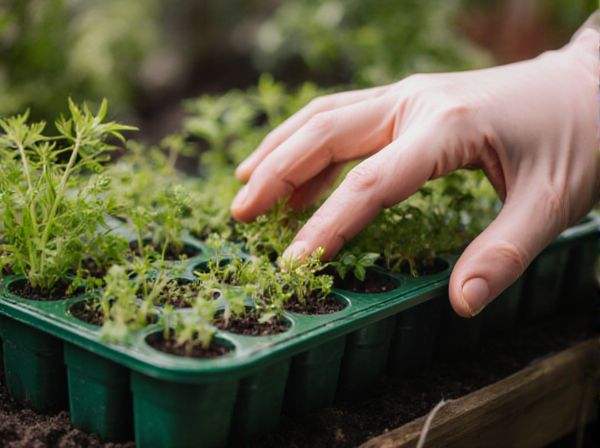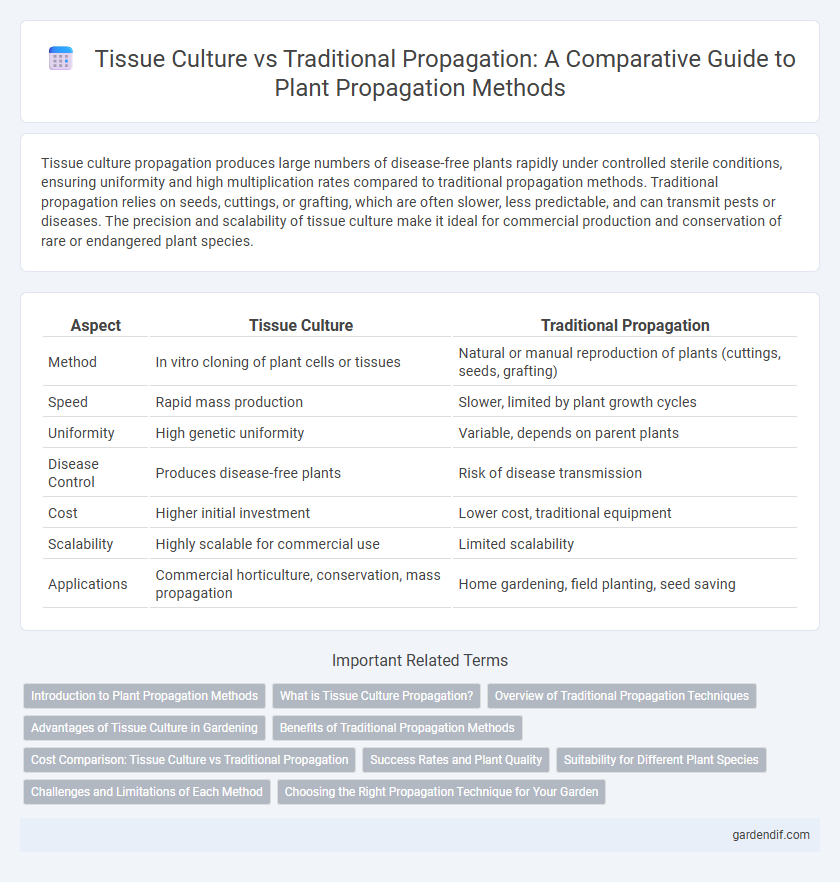
Tissue Culture vs Traditional Propagation Illustration
Tissue culture propagation produces large numbers of disease-free plants rapidly under controlled sterile conditions, ensuring uniformity and high multiplication rates compared to traditional propagation methods. Traditional propagation relies on seeds, cuttings, or grafting, which are often slower, less predictable, and can transmit pests or diseases. The precision and scalability of tissue culture make it ideal for commercial production and conservation of rare or endangered plant species.
Table of Comparison
| Aspect | Tissue Culture | Traditional Propagation |
|---|---|---|
| Method | In vitro cloning of plant cells or tissues | Natural or manual reproduction of plants (cuttings, seeds, grafting) |
| Speed | Rapid mass production | Slower, limited by plant growth cycles |
| Uniformity | High genetic uniformity | Variable, depends on parent plants |
| Disease Control | Produces disease-free plants | Risk of disease transmission |
| Cost | Higher initial investment | Lower cost, traditional equipment |
| Scalability | Highly scalable for commercial use | Limited scalability |
| Applications | Commercial horticulture, conservation, mass propagation | Home gardening, field planting, seed saving |
Introduction to Plant Propagation Methods
Tissue culture propagation involves growing plants in a sterile, controlled environment using small tissue samples, allowing rapid multiplication of disease-free and genetically identical plants. Traditional propagation methods include seed sowing, cuttings, layering, and grafting, relying on natural growth processes but often producing variable results and slower multiplication rates. Tissue culture offers advantages in uniformity and scale, while traditional methods are valued for simplicity and cost-effectiveness in propagation.
What is Tissue Culture Propagation?
Tissue culture propagation is a sterile, laboratory-based technique that involves the growth of plants from small tissue samples or cells on nutrient media under controlled environmental conditions. This method enables the rapid production of genetically uniform and disease-free plants, overcoming limitations of traditional propagation such as seed dormancy and slow multiplication rates. By harnessing micropropagation techniques, tissue culture supports mass production of elite plant varieties with consistent quality and enhanced survival rates.
Overview of Traditional Propagation Techniques
Traditional propagation techniques primarily involve sexual methods such as seed sowing and asexual methods including cuttings, layering, division, and grafting. These methods rely on natural plant reproductive processes and are widely used due to their simplicity and low cost. However, traditional propagation often results in genetic variability and slower multiplication rates compared to tissue culture.
Advantages of Tissue Culture in Gardening
Tissue culture offers precise control over plant growth conditions, ensuring uniform and disease-free seedlings that enhance overall garden productivity. This method enables rapid multiplication of rare or high-demand plants, surpassing the slower, less reliable yields of traditional propagation. By producing genetically identical plants, tissue culture promotes consistent quality and accelerates the introduction of improved cultivars in gardening.
Benefits of Traditional Propagation Methods
Traditional propagation methods offer benefits such as maintaining genetic consistency and preserving unique plant traits through cuttings, grafting, and division. These techniques require less specialized equipment and are often more cost-effective for small-scale gardeners and farmers. Additionally, traditional propagation supports natural growth cycles and can enhance plant resilience in local environmental conditions.
Cost Comparison: Tissue Culture vs Traditional Propagation
Tissue culture propagation offers higher initial setup costs due to specialized equipment and sterile environments, while traditional propagation generally requires lower upfront investment but higher ongoing labor expenses. In the long term, tissue culture can reduce overall costs by producing large numbers of uniform, disease-free plants rapidly, increasing efficiency and marketability. Conversely, traditional propagation costs vary widely depending on species and scale but may incur greater expenses related to slower growth rates and inconsistent plant quality.
Success Rates and Plant Quality
Tissue culture propagation offers significantly higher success rates compared to traditional propagation methods due to its controlled sterile environment and ability to produce disease-free plantlets. Plants derived from tissue culture exhibit enhanced uniformity, vigor, and genetic stability, resulting in superior overall quality. In contrast, traditional propagation often faces challenges such as pest exposure, variability, and lower survival rates, impacting plant consistency and health.
Suitability for Different Plant Species
Tissue culture propagation offers precise control over environmental conditions, making it highly suitable for plants that are difficult to propagate through traditional methods, such as orchids and certain woody species. Traditional propagation, including cuttings and grafting, remains effective and cost-efficient for species with robust natural rooting abilities, like many herbaceous plants and common garden varieties. Selecting the appropriate propagation technique depends on the plant species' biological characteristics and the desired scale of production.
Challenges and Limitations of Each Method
Tissue culture faces challenges such as high initial costs, contamination risks, and the need for skilled labor, limiting its accessibility for some growers. Traditional propagation is limited by slower multiplication rates, dependency on seasonal conditions, and susceptibility to pests and diseases. Both methods require careful management to optimize plant health and yield, balancing efficiency with potential biological constraints.
Choosing the Right Propagation Technique for Your Garden
Tissue culture provides disease-free, uniform plants with faster multiplication rates, ideal for large-scale propagation and rare species conservation. Traditional propagation methods, such as cuttings and seeds, offer cost-effectiveness and simplicity, making them suitable for home gardeners and common plants. Evaluating factors like plant type, scale, budget, and desired growth speed helps determine the best propagation technique for your garden.
Tissue Culture vs Traditional Propagation Infographic

 gardendif.com
gardendif.com